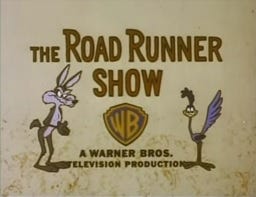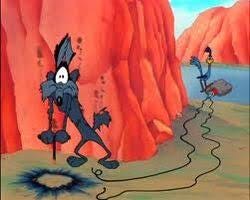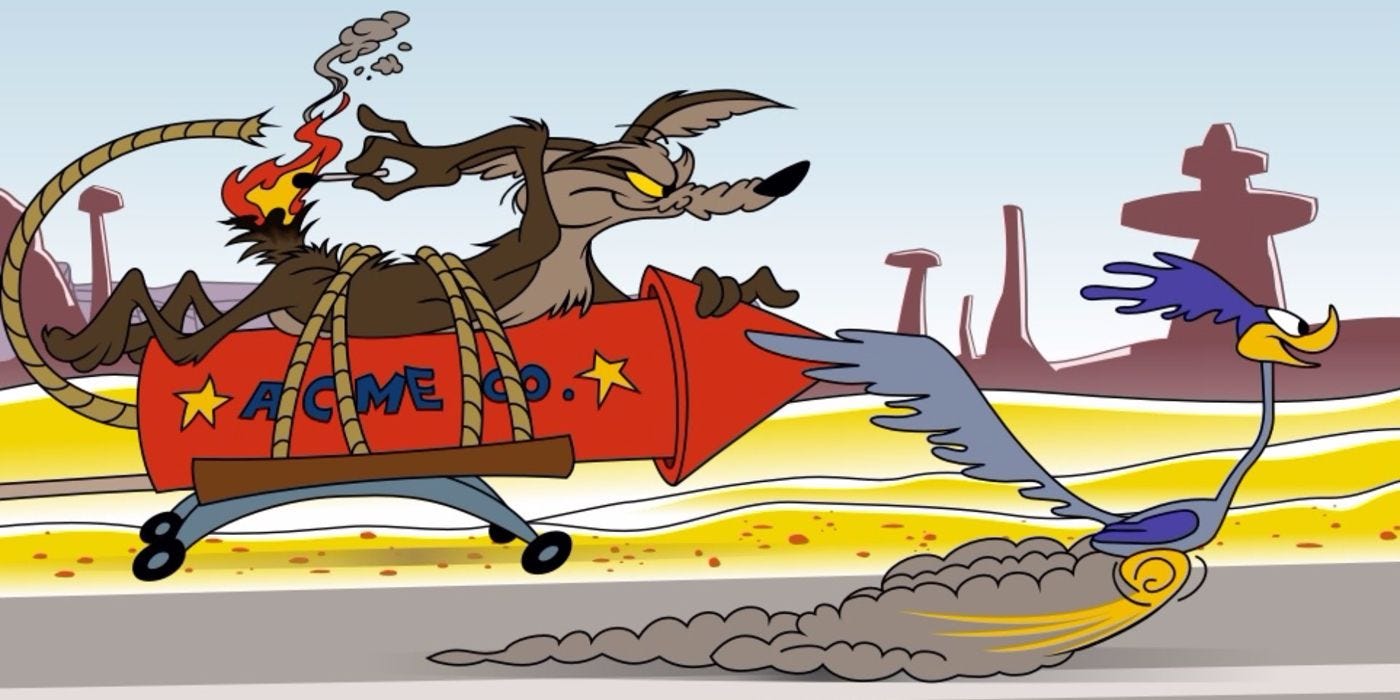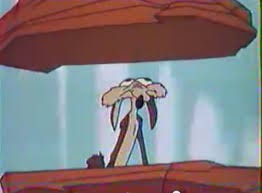I’ve waited a long time to write these words:
Wile E. Coyote is my spirit animal.
I say that without shame or reservation. I can’t tell you exactly when WEC and I first crossed paths. According to Wikipedia, The Road Runner Show debuted in 1966 and was merged into the hour-long Bugs Bunny Show in 1968 or so. I know that it was broadcast on WMT out of Cedar Rapids at 7am on Saturday mornings.
Here was my magical Saturday morning routine back then. I finished delivering my papers around 6:25 am. I ended at the Doerrman’s house, I’d cut through their backyard, behind Mr. Eden’s garage and RV, and I was home. I’d ditch the yellow Des Moines Register bag, grab the bag with the cash I had collected from my subscribers during the week, hop on my bike (a yellow Schwinn 3- speed Sting Ray with the chrome shifter and glittery yellow banana seat) and head off to Mr. Gillespie’s house—he was the Des Moines Register District Manager.
I paid my bill (the wholesale rate for 37 daily newspapers and 44 on Sundays), what was left in the bag belonged to me. From there, it was a lightning fast trip down Koser Ave to Lausen’s Grocery Store, where I conducted a surgical strike to obtain candy: I’m sorry, Mrs. Lausen, no time to chat today. I’m hustling to get home by 7:00 am, and I know the reason the trip down Koser Avenue was so fast is because it was “down” Koser Avenue.The trip home is all uphill. No matter, bag of candy stuffed in my shirt (you can’t have a basket on a Sting Ray), downshift to first gear and I’m home just in time, the opening credits are just rolling at the beginning of the Bugs Bunny Hour. I liked Bugs Bunny; I loved Wile E. Coyote from the very first.
Why did I, why do I, love the Coyote so much?
There are so many obvious points of identification with the Coyote. The futility of the quest, the intensity of the effort, the amount of bald scheming and the utter dejection at every, very predictable failure.After some reflection (a polite way to refer to literally hours of cartoon-watching), I think what I admire the most is that the Coyote left it all on the floor, every single time. The Coyote always played all the way to the whistle; even when he knew he was about to begin that very familiar descent with the dull thud at the end.
I think the Coyote is not given his due and deserves much more respect from us. In doing research for this,1 I compiled a partial list of the running-gag, fake latin names for WEC and the RoadRunner:
You see the kind of unfair theme emerging.The Coyote is nothing but a product of his instincts and character defects and the Road Runner is all noble just because s/he is fast? To me, the Coyote was not some mangy, hare-brained, pseudo-dog. I was more in tune with his original incarnation, think “Quixote,” not “Coyote.” Wile E. Coyote had many fine qualities, among them:
Wile E. Coyote was:
Resourceful
Innovative
Persistent
Urbane
Ironic
Witty
Stubborn
Capable of moments of great self-awareness (typically right before falling began)
Willing to endure repeated and escalating humiliations
Completely deluded and somewhat insane
Able to live life knowing he’s doomed
I loved Wile E. Coyote and his tragic, never-ending, doomed-to-failure quest.
Wile E. Coyote would be a brilliant choice as an AA mascot. He's developed a tremendously unhealthy obsession that has taken over his life, he's got a magnificent, alcoholic-sized ego that won't permit him to admit defeat and he possesses the unshakeable belief that things will be different this time. If WEC were an alcoholic, he would definitely be a big-time relapser. You shake your head every time WEC gets anywhere close to a rocket or lights a fuse that leads to some explosive device: Everyone knows exactly what is going to happen. I think WEC does, too. But he just can't stop.
I had been trying to get sober for a few years and someone insightfully gave me a gift of Road Runner DVD’s. I was watching them one evening, laughing out loud at the same spots I laughed at in 1973, and realized WEC was a lot like me. Everything WEC tried to catch the Road Runner ended not just in failure, but in abject disaster and, often, severe personal injury. Everything I tried to get sober, to stop drinking, somehow managed to end in a place that was worse than where it began. Unpersuaded by the more prosaic, "traditional" methods other people might use to catch their personal Road Runners, I thought attaching a rocket was always a better answer:
We all know how that turns out. I mean, there were variations; sometimes the rocket just hit something solid and blew up, sometimes it would hit a canyon wall that would fling WEC all the way into space; the one thing that never happened? Well, WEC almost never caught the Road Runner.
Chuck Jones, the brilliant animator who conceived of this most clever depiction of the banality and inevitability of repeated failure in the modern world, actually had “Rules” for the Coyote.2
These rules are obviously brilliant! The one that hits with the greatest thud is Rule No. 8 wherein gravity is identified as the Coyote’s real nemesis. Gravity is a remorseless foe; roughly every time I drop something, it hits the ground. Gravity produces very predictable effects, especially on Coyotes who are no longer standing on solid ground. We alcoholics are not great with the concept of gravity, with the idea that doing this is pretty likely to lead to that—just like it did last time? Speaking for myself, I stepped off the edge of the cliff about a thousand times and was surprised every single time I hit the ground. WEC does manage to capture one of the puzzling personality aspects of many alcoholics and addicts; the ability to reason roughly everything away. WEC is either the most optimistic coyote who ever lived (?) or the most deluded.
I just want to say that I’m not exactly sure how many times Wile E. Coyote actually died. As set forth in the Nine Rules of Wile E. Coyote, the Coyote’s injuries were more ego-related than anything else. And that’s obviously at the bottom of WEC’s woes: the Road Runner went from snack to obsession. I know it’s the desert and the food supply is not exactly plentiful; but there has to be more than that one very fast, very lucky Road Runner to eat.There’d better be a Plan B, because here’s the scoop:
You’re probably not going to ever catch the Road Runner.
The central tragedy of WEC is his obsession with an uncatchable bird. I’m not a big fan of the episodes produced by Fritz Freleng in the middle-60’s.They are a little Pink Panther-y for my taste and the score goes from Shostakovich/Prokofiev-like modernist to cheesy French TV music. But there is much more of WEC’s interior monologue on display.You get a sense for his deeply-seated insecurities, his fearfulness as he waits for the next shoe to drop (or himself!), the utter resignation when things turn out exactly the way they did the last 10 times he tried to get the Road Runner to eat explosive or magnetic birdseed. In the cleverly titled “Boulder Wham!” episode, well you can see how Sartre might have drawn the Coyote, or been drawn to the Coyote.
Here’s another thing that never worked for the Coyote: Painting a mural that would trick the Road Runner. Those murals depicted a world that didn’t exist; roads and tunnels that led where the Coyote thought he wanted the Road Runner to go. The illusions never worked, Road Runner never slowed up or changed direction as he powered right through them, exposing them for what they were. But a different fate awaited the creator. WEC would investigate the torn canvas, fuming in that pompous, fake erudite accent: “That absolutely should have worked.” He would then inevitably fall down the canyon he had drawn or worse, be hit by a speeding truck driving the other direction on the road he had just painted. And seriously, you know the AA sayings about how resentments poison us, not the person we direct them at? Isn’t this a much better, more direct illustration of that concept?
I laugh at the repetition of the Coyote’s never-changing fate. But that joke wasn’t nearly as funny during the ten years I was trying to get sober and failing every single time. I’m not sure that Wile E. Coyote is a great example of self-awareness or personal growth, but he’s a pretty good poster-coyote for the idea that a relentlessly-pursued obsession can be pretty damaging.There are a number of other lessons I think can be drawn from the many deaths of Wile E. Coyote:
I can remember avidly watching the Coyote’s futile pursuit of the Road Runner on those Saturday mornings and really, really wanting him to catch the bird. I really felt that. I knew it was a cartoon and that the Tantalusian premise of the show required that he never consummate his pursuit. But I really wanted him to catch the freaking Road Runner.
That was the kind of thinking that was very close to the core of my drinking philosophy. I came to fix on something that I wanted needed, developed very strong feelings very quickly, came to view the object of my desire deeply-felt and very valid need as indispensable, like oxygen, and then couldn’t contain my anger as this thing I had invented (and knew I would never get) didn’t come to fruition. I’m going to tell you what goes really well with that: a flinty, chilled glass of Sauvignon Blanc (or seven).
An important part of my recovery has been developing the ability to identify troublesome thinking patterns.When I look back, I can see this pattern and others, emerge at a pretty early age. I’m not sure where these thinking patterns develop, whether they’re imprinted or passed along or taught, but these ways of thinking started causing me problems in elementary school.That’s how far back I can remember feeling the same kind of resentments that spun through my head on a succession of barstools as an adult. Resentments that were based on a really tilted, not realistic, world view, fueled by assumptions that had almost no connection to reality.
Meaning—these were all inventions of my own thinking, my own brain.
I struggled mightily over the years with intrusive thoughts and anxiety. Seeking relief from that constant strain was definitely part of the allure of drinking. Just like I couldn’t stop drinking, I also couldn’t just stop thinking. I wrote these terrible stories in my head and they drove me to do some terrible things. What I finally learned, from a lot of therapy and several failed rehab attempts was that I could write a different story—if I wanted to.That was an important realization—but it wasn’t enough to keep me sober.
That came when I finally internalized the central teaching of the Big Book: I am not the center of the Universe. There is a Power greater than me that could restore me to sanity. A power that could help me change my outlook from entitlement to gratitude, that could help me start looking at ways I could be of service rather than ways I had been wronged. A power that could help me change my life; save my life.
As mentioned in the earlier explication of the Coyote, we get only glimpses of his true internal struggle in the highly unsatisfying Fritz Freleng episodes. I think we can assume Wile E. Coyote is not terribly happy, he doesn’t smile much and there are no obvious sources of joy in his life. WEC has the makings of a pretty solid alcoholic. But what if the Coyote could have re-framed the central struggle of his life? What if the Coyote could have convinced himself that the point was simply to chase the Road Runner, not catch him? Is there a better, more inventive and creative chaser of Road Runners than Wile E. Coyote? I’ll answer that for you: There is not.
I know that sounds suspiciously easy, very judo-esque—if it was just a matter of thinking a little differently, why did it take so long? It sounds easy, but it took some hard work and involved convincing myself of an entirely different set of premises about life. It took a lot of internal salesmanship. But that’s the point: My drinking was also driven by some pretty persuasive salesmanship. I convinced myself of a lot of ridiculous lies in order to keep drinking. I knew I had the power to change how I thought and what I believed. It just took time and practice—and gratitude and studying the Program—to help me change the story I was living.
Recognizing, as Bill W. did, that I was not the center of the Universe, was what finally sent me down the right path. Recognizing that true happiness comes from service to others, not being served; that I’m a part of a big, crazy, unexplainable thing that can generate tremendous amounts of happiness or sadness, joy or misery. As Shaggy the Yoga Instructor reminds me, “you can’t choose your outcomes, but you can choose how you experience them.” My life finally changed when I stopped imagining how life could be if everything went the way I wanted it to and realized, instead, that I was exactly where I was supposed to be and the things that were happening were generally the things that were supposed to happen.
Until I was willing to see things differently; until I was able to re-frame the purpose of my life; until I was able to see the object of my life couldn’t be a bird I would never catch, well, until then, let’s just say I was well-acquainted with the feeling of clinging to the underside of a boulder as it fell. I knew exactly what that fading, whistling noise meant; the ground was coming up fast. And also, there was probably another rock coming down above me.3
Don’t get me wrong. I laugh every single time I watch a Road Runner cartoon and yes, I’m 60 years old. I love the Coyote and maybe he was a symbol of my active alcoholism, the zillions of relapses and the zillions of crazy, unsuccessful efforts to get sober. But there’s another way to look at it:The Coyote showed up every single, f****** day knowing he was going to take a real beating. He burned up, blew up, was rocketed into space, landed in China once, had trucks and trains run over him, was electrocuted and flattened, and he fell all the way down to that canyon floor a lot.
I know something about that trip and the empty thud at the bottom. But Wile E. Coyote always got up again, dusted himself off, went back to the Acme website and set out to try again. And that may be a pretty good example for my own recovery. Even though everyone had pretty much given up, I kept trying and this time, the edge of the cliff held. Maybe it’s better that Wile E. Coyote will always be out there somewhere chasing the Road Runner. For me, well, it's been a while since I've seen that canyon floor or heard that whistling sound in my ears. I think that’s a pretty good thing.
Long Live Wile E. Coyote!!
Thanks for Letting Me Share
Yes, there was quite a bit of research.
Chuck Jones, Chuck Amuck: The Life and Times of an Animated Cartoonist
See, The Teachings of Wile E. Coyote














